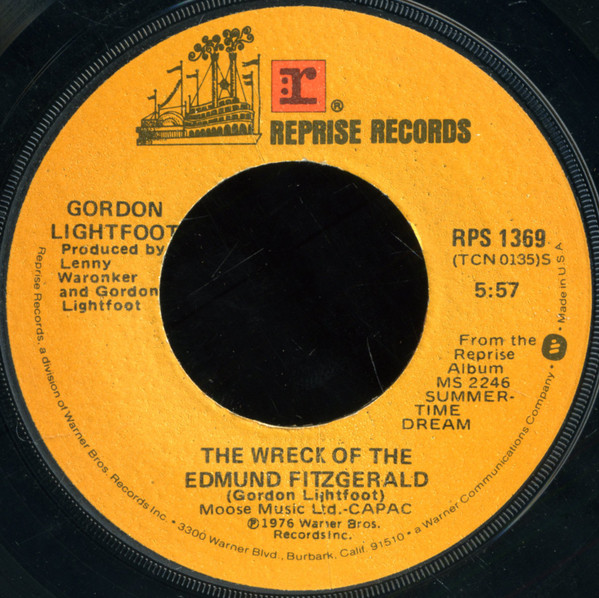Historical
See other Historical Articles
Title: Gordon Lightfoot’s Tale of a Ship’s Crew and Its Captain
Source:
Best Classic Bands
URL Source: https://bestclassicbands.com/gordon ... oot-edmund-fitzgerald-1-22-19/
Published: Aug 10, 2019
Author: Greg Brodsky
Post Date: 2019-08-10 18:47:51 by Deckard
Ping List: *Music* Subscribe to *Music*
Keywords: None
Views: 10215
Comments: 29
Email When listeners first heard Gordon Lightfoot‘s heart-wrenching tale of the 29 brave souls who lost their lives aboard a ship in his 1976 hit, “The Wreck of the Edmund Fitzgerald,” many assumed that he had chosen a subject from perhaps a century earlier. The singer-songwriter had scored a handful of hits in his native Canada and had first come to the attention of worldwide audiences with his 1970 smash, “If You Could Read My Mind.” After a series of mid-chart singles, Lightfoot scored what would be his biggest hit, 1974’s “Sundown,” which reached #1 in the U.S. and Canada. It was followed that same year by another big success, “Carefree Highway.” When “The Wreck of the Edmund Fitzgerald” was released as a single in August 1976, Top 40 audiences listened spellbound to Lightfoot’s tale no matter how many times they heard it. The freighter “with a crew and good captain well seasoned” was traveling from Wisconsin to Detroit – Lightfoot used artistic license to sub-in “Cleveland” as the destination – with a load of “twenty six thousand tons” of iron ore. In the song’s first verse, Lightfoot hints of danger “when the skies of November turn gloomy.” Soon enough, the gales of November came slashin’, when afternoon came it was freezing rain, in the face of a hurricane west wind. As Lightfoot continues, the ship’s cook tells the men that the worsening weather is “too rough to feed ya.” And then, just two lines later, comes the kicker… “Fellas, it’s been good to know ya.” What?!? (That line never fails to elicit chills.) Lightfoot’s lyrics continue: The Captain wired in he had water comin’ in, and the good ship and crew was in peril. And later that night when his lights went out of sight, came the wreck of the Edmund Fitzgerald. Lightfoot’s tale is, indeed, based on a true story. The SS Edmund Fitzgerald sank on Lake Superior, or as the songwriter writes, “Gitche Gumee,” which the poet Henry Wadsworth Longfellow had also called it in his epic poem of 1855, The Song of Hiawatha. But the ship was no 19th century freighter. The sinking of the SS Edmund Fitzgerald had taken place on November 10, 1975. Lightfoot read about it in Newsweek later that month and wrote the song just weeks later. In 2010, he told a Savannah, Ga. publication that he has been to the Maritime Sailors Cathedral in Detroit several times to sing the song and greet the local sea captains. (He describes it in the song’s ending–the church bell chimed ’til it rang twenty-nine times.) The Captain had never sent a distress signal. His last message was, “We are holding our own.” Watch Lightfoot perform the song in 2000, from his Live in Reno DVD The single debuted at #89 on August 28, 1976, ultimately reaching #2 that November, one year after that fateful day. Related: What else was at the top in November 1976? Lightfoot is the subject of a new 2-CD collection, The Complete Singles: 1970-1980, which features all of the A- and B-sides that he recorded for Warner Bros. Records, including the ones mentioned above. It arrives March 1 via Real Gone Music. Lightfoot, born November 17, 1938, keeps a busy tour schedule. Tickets are available here and here.
Poster Comment: The wind in the wires made a tattle-tale sound Pure poetry, worthy of Poe or Longfellow. Living near Lake Superior and remembering the day the ship went down, the song still gives me chills. The songs "Carefree Highway", "Sundown" and "If You Could Read My Mind" are all reminiscent of the late Jim Croce's music.

And a wave broke over the railing
And every man knew, as the captain did too,
T'was the witch of November come stealin'
Post Comment Private Reply Ignore Thread
Top • Page Up • Full Thread • Page Down • Bottom/Latest
Begin Trace Mode for Comment # 8.
#1. To: Deckard (#0)
(Edited)
HaTch covers leaked Ore pelleTs reTained waTer Pumps were useless Waves were up Ship wenT down Had To meeT a dead line Swamped Space shuTTle had BoosTer rockeT leaky o rings RefrigeraTed oxygen NighT freezing cold breezes Had To meet a dead line BP drilling rig WaTered down drilling mud To speed up drilling Had To meeT a dead line LoT of people Unnecessarily dying Love
Hi ...
Yeah Liberals - liberTarians Long on ideals - Theory ShorT on pracTice - realiTy Kahbooom
Right on - Boris.
Deckard lighThead Hah Ps Big mouTh
#9. To: BorisY (#8)
Don’t worry about it Boris. He is mad at me. I kicked his ass really hard today. And since he can’t get to me – he took it out on you. Poor baby …
Top • Page Up • Full Thread • Page Down • Bottom/Latest
boris
#2. To: BorisY (#1)
#3. To: Gatlin (#2)
(Edited)
Kaahlunkk
kaahrash
boris
#6. To: BorisY (#3)
#8. To: Gatlin (#6)
hah
hah
boris
Replies to Comment # 8.
End Trace Mode for Comment # 8.
[Home] [Headlines] [Latest Articles] [Latest Comments] [Post] [Mail] [Sign-in] [Setup] [Help] [Register]
